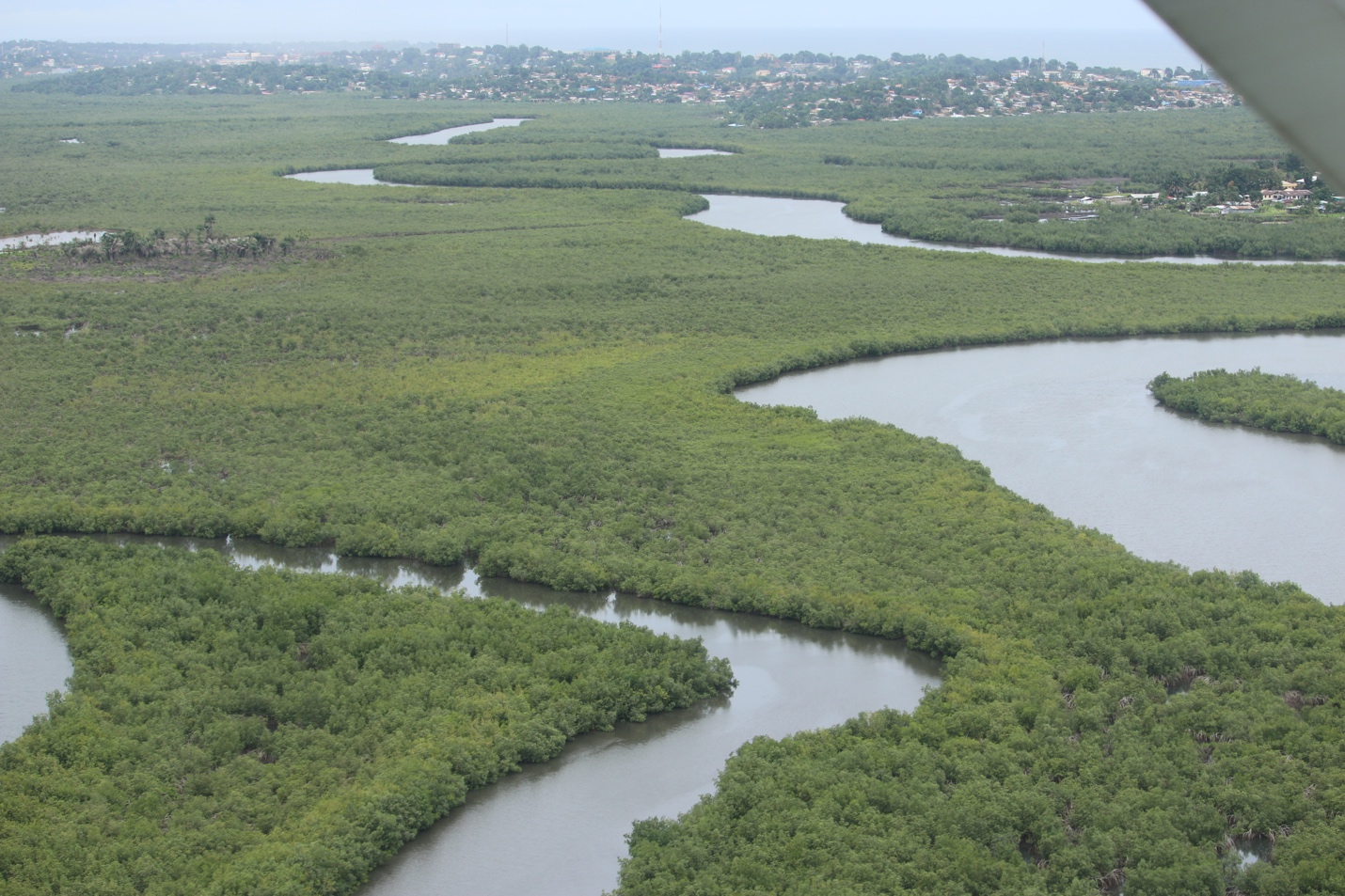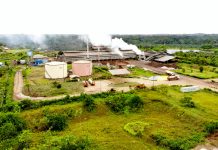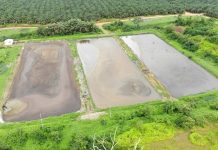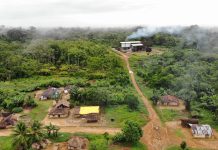Banner Image: A partial, bird’s eye view of a mangrove swamp in Montserrado County. The DayLight/James Harding Giahyue
By Favour Topor
For decades, people have encroached on swamplands or wetlands not knowing the significance of the vital resources that this natural body brings to our ecosystem. For example, people have built and fill in swamplands for the purpose of obtaining properties. But there’s more than wetlands have to offer our ecology and humanity as a whole.
In July 2018, more than 28, 000 people were affected by massive flooding in Montserrado County, including 6,928 children in and out of Monrovia, according to statistics released that year by the National Disaster Management Agency (NDMA). At least 187 homes were damaged by flooding the same year, the agency said at the time. Perhaps, there would be less flooding, wave action, heavy wind, coastal erosion if more people are educated on the significance of keeping the environment less harmful by protecting wetlands or swamplands. Wetlands are also a very valuable source of fresh water for humans and other species.
The water in the wetland is not salty. It’s either fresh or breakage if it is close to the sea, and that is very important for the water flow and the water table. Some people consider wetland as the lungs of the earth because it purifies nutrients, deleterious materials that runoff. It purifies it by going through the wetland and that helps to keep the ecosystem healthy. Wetlands are also disease-ridden places.
Here are six things you need to know about wetlands.
- They help against Flood and Coastal Erosion
Vegetated wetlands along the shores of lakes and rivers can protect against erosion caused by waves along the shorelines during floods and storms. Wetland plants are important because they can absorb much of the energy of the surface waters and bind the soil and deposited sediments in their dense root systems.
“Wetland is a gateway to flood because it serves as a valley of the sink where water is kept. Wetlands have some plants species and grasses that help build resilience against flood,” says Jerry Garteh, science and conservation coordinator at Society for the Conservation of Nature of Liberia (SCNL).
Additionally, Garteh points out the extremely important functions that mangroves and grasses play on wetlands which he said help to keep communities safe from flooding. “Mangrove trees and grass serves as forces which can resist against floods from the ocean to the land. If there was a big flood coming from somewhere, the wetland will control that erosion or that big force and divert it from inland. So, if we do not have wetlands, there will not be a sink where the water can easily go and sink under the soil. Wetland is like a pathway where if you have an erosion taking place, the water will go and direct the root underground. But if there’s no wetland and you only have rock, the water will keep flowing, and this will cause more destruction.”
“Mangrove root is not straight because it is imitating wave action,” says Shadrach Kerwillain, project manager of Fauna and Flora International. “When there’s a strong wave, the mangrove root reduces the current of the water so that before it gets to the shoreline, if it is passing through that water, it loses its potential of rushing further inland.
“The more the mangrove is cut the less the shoreline for a flood. When there’s a strong wind, normally, the storm starts over the ocean and then goes inland or starts over the water body and goes inland in areas that have mangroves, and the impact of the wind is reduced because the mangrove has been adapted to protect against wind action. In areas that don’t have mangroves, the communities and people there are more vulnerable to wave action.’’
- 2. They protect threatened and endangered Species
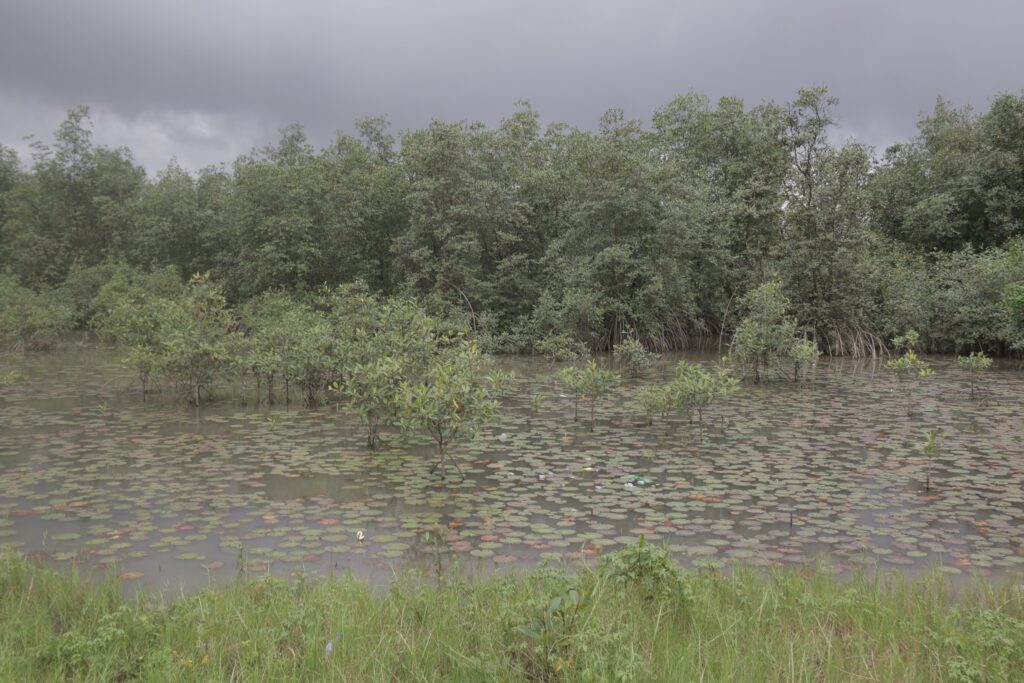
Wetland ecosystems form part of the cradle of biological diversity, providing productivity and survivability for countless plants and animal species. They support high concentrations of birds, mammals, reptiles, amphibians, fish and other invertebrate animals. Wetlands also protect these species from population decline. Wetland provides a home to at least one-third of threatened and endangered species.
“It is mostly lowland rain forest which has riparian areas (wetlands adjacent to rivers) which is the wetland bit of it and a lot of swamp and marshes which can be one of the sources of rich biodiversity. Biodiversity generally is a variety of life, different animals, plants, mushrooms, fungus, and algae,” Shedrack, whose activities is focused in the Sapo National park, the oldest and largest protected area in Liberia.
“Wetland serves as a kind of breeding ground for the most basic organism that supports higher life, using the idea of a food web, wherein you have the bigger people up and the smaller people under and every level in that web of life is important. If you extract, the one above will collapse, and the one under will collapse, too. So, wetland serves that stabilizing role. Fishes go to wetlands to lay their eggs, and mangrove swamp is an easy example of wetland), It serves as a nursery for them because, when fishes lay their eggs in the open ocean, other big fish will eat their eggs, or the waves will take the eggs away from the subscript it’s placed on.”
3. Wetland enhances Farming
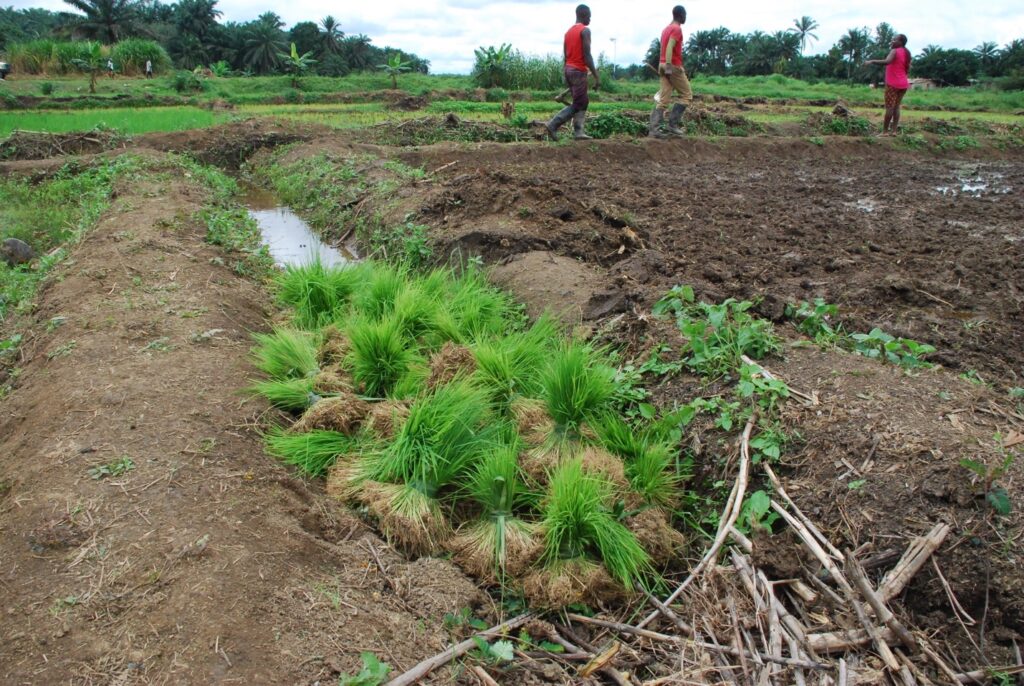
Liberia’s Ministry of Agriculture estimates that fertile lowlands composed of swamps (land saturated by water) and floodplains cover 20 percent of the country’s surface.
In West Africa, Liberia has been an area of a real water source. The country does not have a water irrigation system. Not many wetlands are here in Liberia, but it has lots of swamps at its disposal. In 1979, Liberia joined the Ramsar Convention in Iran. Back in 2003, after signing onto the international convention on the protection of wetlands, it introduced four wetlands of international importance. These include the Montserrado wetland, Marshall Wetland in Margibi, Kpatawee in Bong, and Gbedi in Nimba County.
In Liberia, agricultural activities are widely practiced on wetlands for the purpose of high yielding and fast production. In Liberia’s northeastern Nimba County, the Gedi wetland produces lots of rice. Wetland helps produce more food crops, including vegetables, especially during the dry season of the year. During this period, for instance, more plants on the wetland grow very well because of their moisture nature. Wetland gives more support to the inhabitants of urban settlements such as Monrovia. During the dry season, which comes more sunshine and less rainfall and, during this time of the year, one can easily notice that residents of this metropolitan settlement and its environs harvest lots of potato leaves, corn, and okra from the swamp.
“Humans have been cultivating wetlands for food production since creation. Initially, human settlements primarily occurred in fertile areas, particularly in riverine wetlands along rivers in many places in the world,” explains Richard Sambolah of the Farmers Associated to Conserve the Environment (FACE). “From the early beginning of agricultural activities, such riverine wetlands have been recognized as valuable land areas for food and fodder production, because they have fertile soils as a result of regular sediment deposition during flooding. In Liberia, inland wetlands have been reclaimed for agriculture but also for human habitat.
“The natural wetland ecosystems reclaimed in this way (mainly for agriculture but also for human habitat) have lost much of their original characteristics, leading to reduced biodiversity and reduced performance of functions other than crop productivity (Hassan et al., 2005).”
Not all wetlands are suitable for growing crops. The suitability of a wetland for crop cultivation will depend on two things, according to experts. One is the tolerance of the crop to saltwater conditions and the other the length of time of the wetness of the wetland. Floodplains in river basins in many parts of the world have been used for agriculture because of their natural fertility. Examples are the lower reaches of the Euphrates and Tigris in Iraq, the Rhine in Germany, the Mississippi in the United States, the Danube, which flows through eastern and western Europe, the Po in Italy, the Yangtze in China and the Ganges in India.
“Floodplain sediments are regularly deposited by flooding with river water in very wide, flat areas. The higher parts of these floodplains are highly suitable for growing crops, while the lower parts are wetter but are often suitable for grazing,” says Sambolah. “Floodplain soils are nutrient-rich and are naturally ‘fertilized’ as a result of flooding events.
4. They are suitable for Tourism
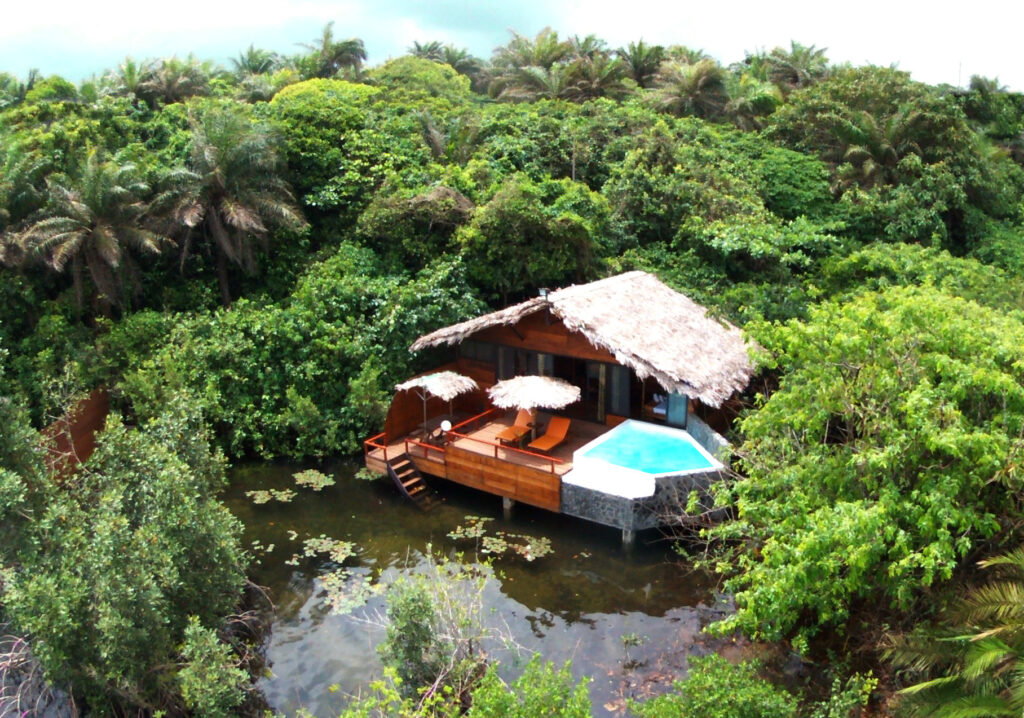
Wetlands are important for tourism because they play a significant role in building communities and national economies, “Wetlands and Tourism’’ was the global theme for World’s Wetlands Day (WWD) celebration in 2012. With half of all international tourists visiting wetlands of different varieties, especially in coastal locations, the tourism expenditure associated with it is expected to be approximately USD 925 billion each year.
Wetlands have given rise to more recreational centers because people love being around water. The landscape formation of wetlands is exceptionally vital for recreational purposes, sightseeing, photography, bird-watching, and hiking because there is a wide variety of plants, animals and water features that provide beautiful places for people to visit. Resorts, theme parks, hotels and other recreational business owners have taken advantage of having their buildings beside Wetlands for the amazing atmosphere that such nature offers.
5. They are a Source of Livelihood
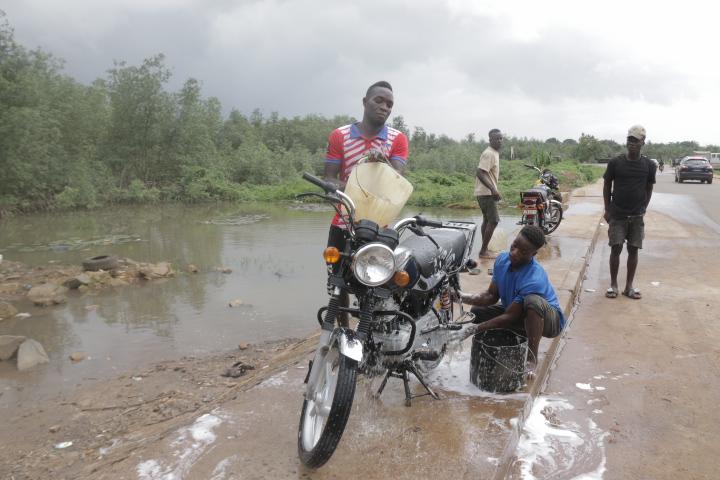
Fishing, rice farming, travel, tourism, job creation, and water provides livelihood in wetlands areas. During the Liberian civil war, the rural dwellers heavily relied on wetlands for energy supply, food, shelter, water, medicine, and other ecological services, according to the Environmental Protection Agency (EPA) survey report which primarily focused on the impact of the Liberian civil war. As a means of acquiring energy for cooking, internally displaced people moved into mangrove forests to collect fuelwood, the report said. It also highlighted specific points where people harvested large portions of the Mesurado and Marshall mangrove Wetland for the purpose of achieving these basic livelihood goals. The EPA finding is a testament that for centuries, “wetlands have played a major role in providing support to our livelihood but we have ignored this fact, or may have forgotten the important roles they play in the 21st century.”
6. Serve as Nursing Ground for Aquatic Species
Birds and animal species, particularly during migration and breeding, rely on wetlands for food, water, and shelter. Thousands of aquatic and terrestrial plants and animal species depend on wetlands for their existence. Wetlands are among the most productive environments on the planet providing shelter and nursery places for commercially and recreationally significant animals such as fish and shellfish, as well as a variety of other plants and animal species.
Why breed on wetland?
“They go to the wetland to breed because the wetland has a lot of organic nutrients. Mangrove leaves, for example, fall in the swamp,” Kerwillain. “The smaller animals that feed on plants feed on these decaying plant materials in the swamp which largely come from broken trees and, when the egg is laid in the mangrove leaf, the small fish eats those other animals that ate the leaf. That helps lead them to get big enough to go back in the sea or river.”
“What you call migratory birds that travel from one country or from one region to another, when flying over a particular area, rest in the wetland and this action by the bird is very deliberate because the wetland provides the highest kind of chances of them getting food. So, some of these fishes will be eaten by these birds that are flying through, then, you see other things like amphibians and reptiles eating smaller animals that ate other things. Therefore, a wetland is a nursery of life in terms of biodiversity, and this is why many plants and animals live on it. It helps to balance the role of smaller and bigger animals, and guarantees the supply of food.”
“When you have mangrove, you have a rich diversity, where you find fish and other things. But, when you cut the mangrove down from that place, it becomes a breeding ground for insects that cause disease. This makes fish and other things that are supposed to feed on those insects vulnerable. There’s a natural spillover effect of this because there’s no wetland for them to feed on.”
Favour Topor is a mass communication student at the University of Liberia. She participated in the “Big Brabee Liberia” television reality show last year and is having an audition for this year’s “Miss Liberia” beauty pageant.

